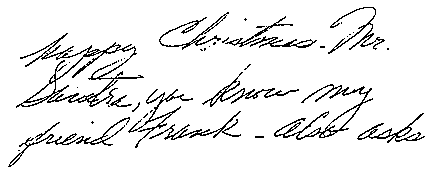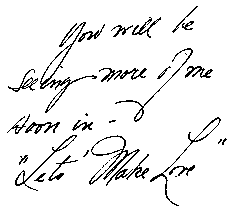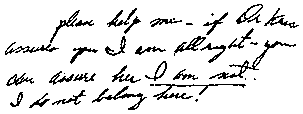MARILYN MONROE
NORMA JEAN
A POOR LITTLE RICH GIRL
A PROFILE IN COURAGE
Her Childhood Was a Nightmare of Ongoing Neglect, Abandonment, And
Rejection Fear of Rejection Creates Different Motivations
The evolution of personality as a result of emotional growth over time is a known fact. Tracking those personality and behavioral changes through the evolution of handwriting is intriguing as it reveals a rare portrait at a point in time. Its graphic message portrays both the highs and lows - emotional despair.
The evolving changes in this "poor little rich girl" can hardly be described as typical as it was played out publicly to some degree. Despite having achieved a spectacular visual pre-eminence, she suffered horrendous insecurity. One only has to track back her history to discover land mines of insecurity that pock marked her very short life.
Norma's mother married and divorced twice and had several affairs prior to giving birth to Norma.
She, apparently, had been so promiscuous she had no idea who Norma's biological father was. Her Husband divorced her and moved across the country taking the other two children. Norma didn't find out she had a half sister and a half brother until she was 12 years old. Although her half brother had died, she became close to her half sister.
Her childhood was a nightmare of ongoing neglect, abandonment, rejection. Her mother was very unstable as was the grandmother, who tried to smother Norma when she was about two. The mother had violent fits of rage and depression and could only care for her haphazardly, leaving her with friends or family for weeks. Curiously, while the mother was quite promiscuous, she was religiously superstitious and consumed fears regarding sin, some of which she claimed little Norma harbored in her soul.
When her mother became increasingly indifferent and more emotionally unstable, she put Norma in a foster home so that she would be free of the burden of having a child around. Several months later, she'd take her back. This pattern was repeated several times over the years. So much so that Norma had been in 10 different foster homes, had spent two years in the Los Angeles Orphan's Home and had lived with a guardian for several years of her young life. Unfortunately, the guardian's husband sexually molested her, and a neighbor raped her, leaving her pregnant. Although she was allowed to bear the baby, it was taken away soon after birth; she never again saw her son.
When Norma was 16, her guardian moved out of state and did not want to take her. Consequently, she was given the option of either marrying the son of a neighbor whom she knew only vaguely or going back to the orphanage. She chose to marry the young man five years older than she; he joined the navy soon thereafter. The marriage lasted but a few years before she filed for a divorce.
Rejection Fear of Rejection Creates Different Motivations
The evolution of personality as a result of emotional growth over time is a known fact. Tracking those personality and behavioral changes through the evolution of handwriting is intriguing as it reveals a rare portrait at a point in time. Its graphic message portrays both the highs and lows - emotional despair.
The evolving changes in this "poor little rich girl" can hardly be described as typical as it was played out publicly to some degree. Despite having achieved a spectacular visual pre-eminence, she suffered horrendous insecurity. One only has to track back her history to discover land mines of insecurity that pock marked her very short life.
Norma's mother married and divorced twice and had several affairs prior to giving birth to Norma.
She, apparently, had been so promiscuous she had no idea who Norma's biological father was. Her Husband divorced her and moved across the country taking the other two children. Norma didn't find out she had a half sister and a half brother until she was 12 years old. Although her half brother had died, she became close to her half sister.
Her childhood was a nightmare of ongoing neglect, abandonment, rejection. Her mother was very unstable as was the grandmother, who tried to smother Norma when she was about two. The mother had violent fits of rage and depression and could only care for her haphazardly, leaving her with friends or family for weeks. Curiously, while the mother was quite promiscuous, she was religiously superstitious and consumed fears regarding sin, some of which she claimed little Norma harbored in her soul.
When her mother became increasingly indifferent and more emotionally unstable, she put Norma in a foster home so that she would be free of the burden of having a child around. Several months later, she'd take her back. This pattern was repeated several times over the years. So much so that Norma had been in 10 different foster homes, had spent two years in the Los Angeles Orphan's Home and had lived with a guardian for several years of her young life. Unfortunately, the guardian's husband sexually molested her, and a neighbor raped her, leaving her pregnant. Although she was allowed to bear the baby, it was taken away soon after birth; she never again saw her son.
When Norma was 16, her guardian moved out of state and did not want to take her. Consequently, she was given the option of either marrying the son of a neighbor whom she knew only vaguely or going back to the orphanage. She chose to marry the young man five years older than she; he joined the navy soon thereafter. The marriage lasted but a few years before she filed for a divorce.
Figure 1: This is a persona writing of a young LH teenager with a turbulent childhood, before she began her ascendancy to fame.
Figure 1 was written during Norma's teenage years about the time she married. An important graphological issue is that she was left handed indicating she was inherently more vulnerable to the emotional influences of the right brain. This early sample, a clear persona writing, (left slanted, straight baseline, low t-bars, regularity in letter forms and spacing) reveals a strong degree of emotional reserve and cautiousness - she learned early to repress her feelings.
She had blossomed into an incredibly beautiful, extremely photogenic young woman. Although she lacked guidance, she slowly began to explore the world trying to find ways to support herself.
Over the next few years, she worked briefly as a call girl and a model. That led to posing for an infamous nude photo that flung open the doors to fame and fortune.
Figure 1 was written during Norma's teenage years about the time she married. An important graphological issue is that she was left handed indicating she was inherently more vulnerable to the emotional influences of the right brain. This early sample, a clear persona writing, (left slanted, straight baseline, low t-bars, regularity in letter forms and spacing) reveals a strong degree of emotional reserve and cautiousness - she learned early to repress her feelings.
She had blossomed into an incredibly beautiful, extremely photogenic young woman. Although she lacked guidance, she slowly began to explore the world trying to find ways to support herself.
Over the next few years, she worked briefly as a call girl and a model. That led to posing for an infamous nude photo that flung open the doors to fame and fortune.
Figure 2: This sample was written in the midst of an exuberant transition; she was well on the road to fame and fortune
.
Figure 2 was written during her meteoric rise to stardom. She had learned to let go of some of the strong inhibitions in the earlier sample and projects the image of a dynamic, vivacious, exuberant albeit emotionally vulnerable, very insecure young woman, (irregular, exaggerated mid zone letters, extreme right slant, rising letters that bounce up and down, inflated d stem).
Considering the early emotional neglect she was subjected to, emotional insecurity is a given. Dr. R. Joseph indicates the effects of insecurity can create different motivations. In one case, the fear of rejection is such that the individual is paralyzed so that nothing is ever ventured. Or it can spawn a desperate motivation to prove one's self to the world to gain the love and approval of which she had been deprived.
Those troubled souls drive themselves in seeking superiority, fame, or acclaim, applause and admiration of others to overcome their sense of feeling unworthy, inferior, unwanted, inadequate or unloved.
Having begun to tap the power of her emotional resources in climbing her way to the top, she was exuberant in her efforts yet was never but a step away from being an extremely vulnerable waif who was consumed with anxieties and insecurities.
.
Figure 2 was written during her meteoric rise to stardom. She had learned to let go of some of the strong inhibitions in the earlier sample and projects the image of a dynamic, vivacious, exuberant albeit emotionally vulnerable, very insecure young woman, (irregular, exaggerated mid zone letters, extreme right slant, rising letters that bounce up and down, inflated d stem).
Considering the early emotional neglect she was subjected to, emotional insecurity is a given. Dr. R. Joseph indicates the effects of insecurity can create different motivations. In one case, the fear of rejection is such that the individual is paralyzed so that nothing is ever ventured. Or it can spawn a desperate motivation to prove one's self to the world to gain the love and approval of which she had been deprived.
Those troubled souls drive themselves in seeking superiority, fame, or acclaim, applause and admiration of others to overcome their sense of feeling unworthy, inferior, unwanted, inadequate or unloved.
Having begun to tap the power of her emotional resources in climbing her way to the top, she was exuberant in her efforts yet was never but a step away from being an extremely vulnerable waif who was consumed with anxieties and insecurities.
Figure 3: By reining in her exuberance she learned to marshal her emotional energy more effectively and formed her own production company.
Figure 3 was written further along in her path to fame and fortune. Having learned to temper her strong reactive exubrance to some degree, it allowed her to marshal her emotional energy more effectively, (regularity in slant, baseline and letter size). But the signs of inflated ego (extreme capital letters) suggest that she had not yet achieved balance in her life as the extreme zonal imbalance suggests.
Along the way, she had numerous simultaneous affairs, usually with older men; she became repeatedly pregnant. Over the course of 21 years, she underwent 12 abortions.
She was married and divorced several times to prominent men, and in the safety of marriage, she endured terrible anguish in not being able to carry a pregnancy to term.
As her fame grew, so did her massive anxiety and depression. Anxieties (seen in the narrow letter spacing and narrow o's) consumed her; she was notorious for holding up production which sent budgets escalating into the stratospheres.
Yet despite repeated suicide attempts and alcohol and drug abuse, she somehow managed to forge a movie career, becoming one of the world's most sought after glamorous femme fatales.
Figure 3 was written further along in her path to fame and fortune. Having learned to temper her strong reactive exubrance to some degree, it allowed her to marshal her emotional energy more effectively, (regularity in slant, baseline and letter size). But the signs of inflated ego (extreme capital letters) suggest that she had not yet achieved balance in her life as the extreme zonal imbalance suggests.
Along the way, she had numerous simultaneous affairs, usually with older men; she became repeatedly pregnant. Over the course of 21 years, she underwent 12 abortions.
She was married and divorced several times to prominent men, and in the safety of marriage, she endured terrible anguish in not being able to carry a pregnancy to term.
As her fame grew, so did her massive anxiety and depression. Anxieties (seen in the narrow letter spacing and narrow o's) consumed her; she was notorious for holding up production which sent budgets escalating into the stratospheres.
Yet despite repeated suicide attempts and alcohol and drug abuse, she somehow managed to forge a movie career, becoming one of the world's most sought after glamorous femme fatales.
Figure 4: The writer is caught in the throes of one of a number of breakdowns.
Figure 4 was written at one of the many low points in her life in a battle with depression to the point of breakdown (drooping, miniscule letters, varying baseline, irregular spacing).
Dr. Joseph suggests, the more a parent rejects and withholds love, and is overly critical, frequently absent, mentally ill, drugged, or intoxicated, the more the child is plagued with the underlying feelings of unworthiness.
Lack of emotional bonding in her very early years due to a sick, disturbed, rejecting mother generated a massive black hole of emotional insecurities that could never be filled.
The need for love that was denied her from infancy unconsciously (i.e. emotionally) taught her that she did not deserve love, and she spent a lifetime looking for it.
Despite some eight years of therapy, she had been plagued her entire life by fear, anxiety, self doubt, and a very needy emotional dependence that often alienated those who were attracted to her. Such feelings of inadequacy often can spawn self destructiveness.
After having a number of reported liaisons with an American president, she died at the young age of 36.
Recurring speculation over the years has been that she may have been killed due to the considerable potential for serious political damage arising from those political connections. Indeed, 35 years after her death, that speculation has resurfaced. However, the official answer was more likely that it was finally a successful suicide.
Yet she was one of the most beautiful, and recognizable actresses in the last 40 years. Her unexpected death at such an early age hurled her towards an icon status. They buried her under the name of Marilyn...
Figure 4 was written at one of the many low points in her life in a battle with depression to the point of breakdown (drooping, miniscule letters, varying baseline, irregular spacing).
Dr. Joseph suggests, the more a parent rejects and withholds love, and is overly critical, frequently absent, mentally ill, drugged, or intoxicated, the more the child is plagued with the underlying feelings of unworthiness.
Lack of emotional bonding in her very early years due to a sick, disturbed, rejecting mother generated a massive black hole of emotional insecurities that could never be filled.
The need for love that was denied her from infancy unconsciously (i.e. emotionally) taught her that she did not deserve love, and she spent a lifetime looking for it.
Despite some eight years of therapy, she had been plagued her entire life by fear, anxiety, self doubt, and a very needy emotional dependence that often alienated those who were attracted to her. Such feelings of inadequacy often can spawn self destructiveness.
After having a number of reported liaisons with an American president, she died at the young age of 36.
Recurring speculation over the years has been that she may have been killed due to the considerable potential for serious political damage arising from those political connections. Indeed, 35 years after her death, that speculation has resurfaced. However, the official answer was more likely that it was finally a successful suicide.
Yet she was one of the most beautiful, and recognizable actresses in the last 40 years. Her unexpected death at such an early age hurled her towards an icon status. They buried her under the name of Marilyn...
Biography of Marilyn Monroe
|
Background: Marilyn Monroe:
Some not so well known events in Marilyn's life. Marilyn's grandmother and mother were both diagnosed with paranoid schizophrenia. Marilyn's mother Gladys had witnessed violent behavior between her parents. Marilyn's grandfather, Mr. Monroe (first name is not known) once took a pet kitten out of daughter Gladys' hand and flung it against a brick fireplace. Delia Monroe, Marilyn's grandmother, was prone to rages and outbursts. It was said that a newspaper boy was afraid to knock on her door. Though she appeared to love her granddaughter, once when Marilyn (at 4-5 months of age) threw a bowl of food on the floor, Delia repeatedly spanked her. |
Another episode occurred shortly before Delia was committed to a state hospital in the summer of 1927. Delia had taken 13 month old Norma Jean for the afternoon. Marilyn, later told her third husband, Arthur Miller, that she awoke from her nap and could hardly breath because something was pressed against her, perhaps a pillow. It has been said that an infant that young could not remember such an episode, but people close to Marilyn believe it happened. Gladys' first husband (Baker) had permanent possession of her other two children, Jack and Berneice. When admitted to the hospital to give birth to Marilyn, Gladys would state that her other two children were "dead". Gladys would have long periods of depression where she would feel lonely and rejected. She was given to outbursts of uncontrollable laughter and crying. In 1934, she became hysterical and suffered a nervous breakdown. She was carried away, strapped in a stretcher and was later committed to the State Asylum in Norfolk. Marilyn would suffer her own nervous breakdown in 1960. Marilyn claimed that she had been raped at 7 or 8 years of age. Marilyn was devastated that she could not have a child. She suffered two miscarriages and was rumored to have had a child when she was a teenager (note: this is contested by some who claim this never happened) and had given it up for adoption. The long delays in the shooting in the hot Nevada sun of "The Misfits" contributed to the death of her co-star Clark Gable, who Marilyn had secretly pretended was her father. Marilyn was upset to learn that while she was earning $100,000 a picture, Elizabeth Taylor was being paid $1,000,000 for "Cleopatra". However, shortly before her death Marilyn was thrilled to know that the publishing of her nude photos would push Liz off the front pages. Towards the end of her life, Marilyn was so dependent on drugs and alcohol that it would take the whole day to complete one scene of film footage. The preceding information was researched by Rosa Silvestri. Guest Analyst: Jeanette Farmer, C.G. |








